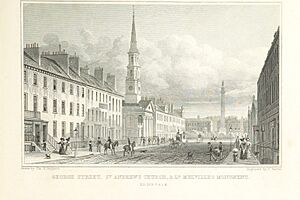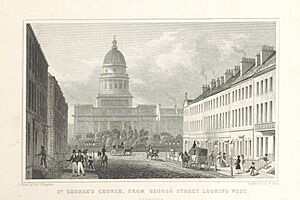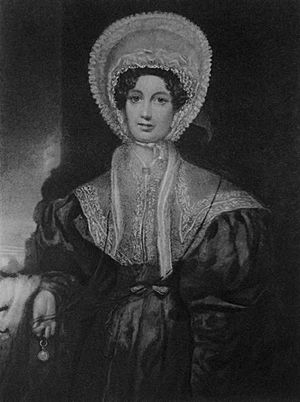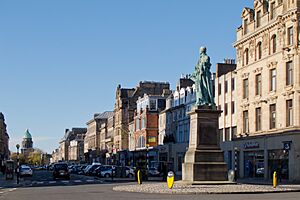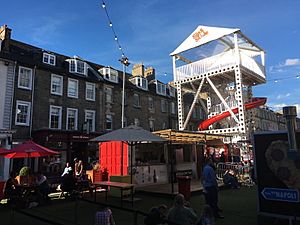George Street, Edinburgh facts for kids
George Street is a famous street in the heart of Edinburgh, Scotland. It's part of the city's "First New Town", which was planned way back in the 1700s by an architect named James Craig.
The street is named after King George III. It stretches from St Andrew Square in the east to Charlotte Square in the west. George Street is located north of Edinburgh's historic Old Town, sitting between Princes Street and Queen Street. It runs straight along a high ridge, offering great views.
When George Street was first planned in 1767, it was meant to be a place for homes. But during the Victorian period (the 1800s), many of these houses were replaced by shops, banks, and hotels. Some of these grand buildings were designed by a well-known architect, David Bryce, who even lived on the street himself!
Today, George Street still looks a lot like it did in the Victorian times. However, many of the old commercial buildings are now restaurants, coffee shops, bars, and fancy clothing stores.
Contents
Famous Buildings on George Street
George Street is home to many interesting and historic buildings. Here are some of the most notable ones, listed by their address.
Buildings on the North Side
- 13 - St Andrew's and St George's West Church: This church, originally called St Andrew's Church, was built in 1784.
- 15-17-19 - Caledonian Insurance Company: Designed by David Bryce in 1839-1840. Part of it later became the George Hotel.
- 19-21 - The Principal: This hotel, originally called The George Hotel, opened in 1881. It combines Bryce's building with five older townhouses.
- 25 - Home of Susan Ferrier: The famous novelist Susan Ferrier lived here from 1784 until about 1830.
- 65 - Dowells Auctioneers: This building, made of pale pink sandstone, was built in 1907-1908.
- 89 - Gray's of Edinburgh: A five-story shop built in 1902. It was home to Gray's of Edinburgh hardware shop for over 100 years.
- 95, 95A - Insurance Company of Scotland: Another building designed by David Bryce in 1840.
- 101-103 - Bank of Scotland: This former bank branch was built in 1882-1883.
- 117-121 - Church of Scotland Headquarters: The main offices for the Church of Scotland were built here between 1909 and 1911.
- 131 - David Bryce's Home: The architect David Bryce lived here and rebuilt the house in 1883.
Buildings on the South Side
- 14 - The Dome: This grand building was designed by David Rhind and built in 1847. It was originally the main office for the Commercial Bank of Scotland. Before that, it was the site of the Physicians' Hall.
- 22-24-26 - The Royal Society of Edinburgh: This important scientific society is located in a building that used to belong to the Edinburgh Life Assurance Company.
- 44 - Trotters Opticians: This shop was restored in 1985 to look like it did in an earlier time.
- 54 - Assembly Rooms: These famous rooms, used for events and gatherings, first opened in 1787.
- 62-64-66 - Union Bank of Scotland: Another building designed by David Bryce in 1876.
- 80 - Professional and Civil Service Supply Association: This was once a large department store.
- 84 - Northern Lighthouse Board: This is the headquarters for the organization that manages lighthouses around Scotland.
- 96 - Freemasons' Hall: The main building for Scottish Freemasonry.
- 120 - Cleghorn & Co: A modern-style building built in 1924-25 for a leather goods shop.
- 130 - Mabel Dawson's Studio: This was once the art studio of the artist Mabel Dawson.
Statues on George Street
You'll find several statues along George Street, each honoring an important person:
- Thomas Chalmers: A famous churchman (1780–1847). His statue was put up in 1878 at the crossing with Castle Street.
- William Pitt the Younger: A British prime minister (1759–1806). His statue, from 1831-3, is at the crossing with Frederick Street.
- King George IV: The king who reigned from 1820 to 1830 (1762–1830). His statue was made to remember his visit to Scotland in 1822 and is at the crossing with Hanover Street.
- James Clerk Maxwell: A Scottish scientist (1831–1879). His statue, from 2008, is at the east end of George Street, near St Andrew Square.
George Street's Recent Changes
In 2011 and 2012, George Street became a very important road. This was because Edinburgh's tram project meant that the nearby Princes Street was closed. During this time, many more people walked on George Street. By 2013, it was known as "the city’s most prestigious shopping district."
In 2012, the City of Edinburgh Council tried out a new plan for George Street. For a year, starting in June 2014, vehicles could only go one way. A special two-way bike lane was added. Restaurants and bars also got more outdoor space. This trial helped the council decide on future plans for the street.
Future Plans for George Street
A new project called 'George Street and First New Town Redesign' started in 2018. The goal is to make the area more lively and safer for everyone. It aims to make it easier for people to walk and cycle.
In 2021, new ideas were shared that would make most of George Street a pedestrian-only area. This means fewer cars and more space for people!
George Street During the Edinburgh Festival
George Street has become a key spot during the Edinburgh Festival in August. Pedestrian areas are made larger, and there's less space for traffic.
In August 2016, a new event called WestFest took place on the western part of George Street. This section was closed to cars. The event had fun activities like a whisky experience, a mobile cinema, and mini-golf. Many restaurants on George Street also added extra outdoor seating during the festival.
Images for kids
-
Statue of James Clerk Maxwell by Alexander Stoddart from 2008, at the east end of George Street.


